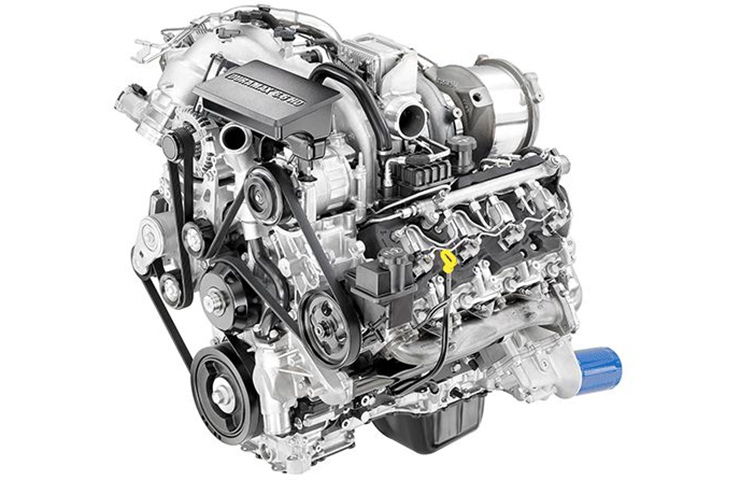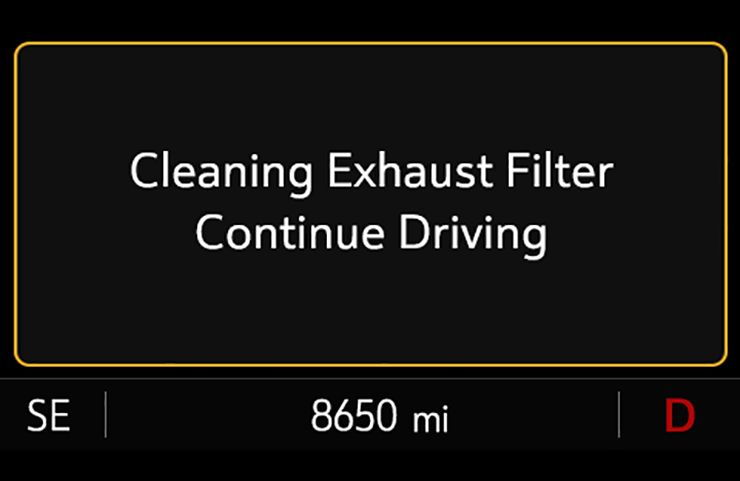What Does Cleaning Exhaust Filter Mean
The diesel exhaust organization on 2017-2018 Silverado and Sierra models and 2019-2020 Silverado 2500/3500 and Sierra 2500/3500 models equipped with the 6.6L Duramax diesel engine (RPO L5P) (Fig. 1) requires an occasional Diesel fuel Particulate Filter (DPF) cleaning. Under normal driving conditions, the DPF cleaning occurs without any driving interest. However, in that location may be circumstances that crave a service regeneration to be performed.
 Fig. one
Fig. one
DPF Soot Level
Beginning with 2017 Silverado and Sierra models, the DPF Soot Accumulation is measured in percent instead of grams in GDS ii. The ECM will non try to perform a regeneration until the DPF Soot Accumulation increases to approximately 100%. If the DPF Soot Accumulation increases to 115% and the system has non been able to regenerate, the "Continue Driving" bulletin will brandish on the Driver Information Center (DIC). If the DPF Soot Accumulation increases to 140%, DTC P2463 (DPF Soot Aggregating) will gear up and a service regeneration will exist required to clean the DPF.
At that place are two soot level readings in GDS2. One uses the differential force per unit area sensor to calculate the soot in the DPF and the other uses other engine data. If either of these reaches the threshold, a regeneration will be performed.
Service Regeneration
A Service Regeneration is designed to lower the soot accumulation in the DPF in a very controlled manner. Information technology is not as constructive at lowering the soot accumulated in the DPF as a Regeneration Enable followed past a bulldoze.
Only perform a service regeneration if instructed in the appropriate Service Information. If in that location is a concern well-nigh the DPF Soot Accumulation, perform a regeneration enable and return the vehicle to the customer.
Vehicle Idling
Some vehicles may spend a lot of fourth dimension idling. Use the following steps to aid in determining the equivalent mileage (kilometers):
- Record the total engine hours indicated on the DIC.
- Multiply the engine hours by 33 miles or 53 km. This represents an average speed of 33 MPH or 53 KM/H.
- The effect should be close to or lower than the mileage on the odometer.
For example, if a vehicle has 1812.3 engine hours and 60,837 miles (97,908 km) on the odometer, the engine run time would equate to most 59,806 miles (96,052 km) (1812.3 X 33 = 59,806) (1812.3 X 53 = 96,052).
Since the calculated mileage is less than the actual mileage, the vehicle does not spend an excessive amount of time idling.
If the calculated mileage is more than the actual mileage, the vehicle would be considered a vehicle that idles a lot and this information may be useful in diagnosing whatever issues.
TIP: The engine hours formula should exist used to aid in engine diagnosis only. It should not be used to determine any warranty claims.
How Regeneration Should Occur
The DPF traps the soot generated as a part of the normal operation of a diesel engine so that it is not sent into the environment. The process of regeneration enables the vehicle to clean the filter so it can trap more soot. Factors that make up one's mind when the ECM will try to perform a regeneration include:
-
- After approximately 36 gallons (136 L) of fuel used since the last regeneration.
-
- A maximum altitude of 800 miles (1287 km) take been traveled since the last regeneration.
-
- A pre-determined number of engine hours since the final regeneration.
-
- A calculated or measured soot mass of 100% in the particulate filter.
When whatever of the above criteria are met, the ECM will perform a regeneration as shortly equally all the right conditions are met. If the ECM cannot perform a regeneration, the ECM will merely look at the soot mass to determine to display the Continue Driving DIC bulletin or to set DTC P2463.
The ECM uses the post-obit criteria to perform a regeneration:
-
- Vehicle in Drive
-
- BARO sensor 1 is more than 51 kPa (7.four PSI)
-
- Engine speed betwixt 500 and 4000 RPM
-
- Exhaust Gas Temperature Sensor 1 betwixt 100 and 725 C
-
- Frazzle Gas Temperature Sensor 2 between 95 and 750 C
-
- Exhaust Gas Temperature Sensor 3 between 0 and 750 C
-
- Exhaust Gas Temperature Sensor 4 between 60 and 750 C
-
- Exhaust Gas Temperature Sensor 4 between threescore and 850 C
-
- Engine Coolant Temperature between 50 and 140 C
-
- Intake air temperature between -70 and 250 C
-
- Fueling from -1 to 165mm3
-
- Vehicle speed from -1 to 160 km/60 minutes
-
- No active DTC related to EGR, Indirect injector, or Throttle (heave)
The vehicle does non accept a soot level sensor to decide how much soot is in the DPF. It uses algorithms to calculate the soot mass.
DTC P2463
When DTC P2463 sets, the ECM volition no longer try to perform a driving regeneration and the vehicle will require the more than controlled service regeneration. There are a number of factors that tin can cause the lawmaking to set, including:
-
- The driver ignoring the Go along Driving messages
-
- Leaks from intake or frazzle arrangement
-
- Poor fueling in the engine
-
- Contaminated or bad fuel
-
- Externally damaged or worn components.
-
- Loose or improperly installed components
-
- Dirty components (air filter or TMAP sensor)
-
- Driving way, such as binary driving (oftentimes on/off accelerator or brake)
High Soot Levels
Factors that contribute to generating high levels of soot include:
-
- Charge air libation (CAC) and Air consecration organisation leaks.
-
- A restricted air filter.
-
- Frazzle organisation leaks that may cause inaccurate Exhaust Gas Temperature sensor or Frazzle Force per unit area Differential sensor values.
-
- Failed, intermittent, improperly installed, incorrectly wired or loose Frazzle Gas Temperature sensors may crusade inaccuracies in the soot model. Look at all temperature sensors when the vehicle is cold to verify that they read close to each other.
-
- Improperly routed differential pressure lines. The frazzle differential pressure line should have a continuous downwardly gradient without any sharp bends or kinks from the sensor to the DPF.
-
- Leaks or internal restrictions from the Exhaust Pressure Differential sensor lines.
-
- A skewed or shifted Exhaust Pressure Differential sensor will cause inaccuracies in the soot model.
-
- A cracked or damaged MAF sensor housing.
-
- A skewed, stuck in range, or slow responding MAF sensor. Audit the MAF sensor for contamination.
-
- Indirect Fuel Injector leaking or restricted.
-
- Externally damaged or worn components.
-
- Loose or improperly installed components.
-
- Water in fuel contagion.
-
- Engine mechanical condition, such as depression compression.
-
- Vehicle Modifications
Reducing the Number of DPF Regenerations
If a customer asks what tin be washed to reduce the number of DPF regenerations needed. Explain that when the "Go along Driving" message is displayed (Fig. ii), the vehicle should be driven safely at a steady speed as shut to the posted speed limit every bit possible, until the bulletin turns off, which can have upwards to thirty minutes.
 Fig. 2
Fig. 2
In improver, driving with cruise control when possible will help the engine perform more than efficiently also as assist the engine burn cleaner, resulting in less regenerations.
Driving at a steady stride without aggressive throttle application also will reduce the amount of soot generated by the organisation.
When descending an incline, apply Tow/Booty fashion to help with the power of the vehicle to perform a regeneration.
The utilise of the diesel exhaust brake on declines volition also help adapt the gearing to permit the vehicle to perform a regeneration. Keep in mind that on 2020 models, the diesel exhaust brake may not be as noticeable as in prior model year vehicles.
– Thanks to Larry Yaw and Rob Ritz
What Does Cleaning Exhaust Filter Mean,
Source: https://gm-techlink.com/?p=13566
Posted by: vinsonpaun1939.blogspot.com


0 Response to "What Does Cleaning Exhaust Filter Mean"
Post a Comment